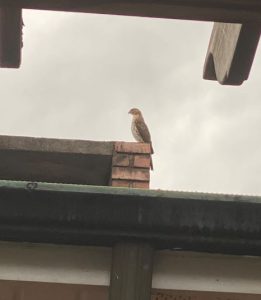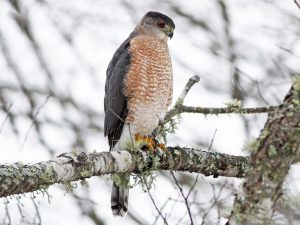
My family likes to give me a hard time about my bird identification skills, or lack thereof. In the woods or water, I can generally name any given tree, fish, or mammal on the spot. But point out a bird, and it’s a different story. Sure, I can ID the major ones—eagles, ospreys, blue herons, mockingbirds, flamingos at the zoo—but once you delve into the myriad species of hawks or songbirds, I’m kind of lost. I have listened to dozens of Florida Master Naturalist presentations given by my colleagues (and students) on birds, but the information just doesn’t seem to stick. So, when I got a text from a neighbor late last Saturday night asking if I knew “what kind of bird this is?” with a photo attached, I had to laugh. I truly had no idea, but these are indeed the kinds of wild late-night texts I get.
I did know enough to recognize that it was a hawk, and I was pretty sure it was the same kind I’d seen darting low over the streets and in yards throughout our neighborhood. It is fast, flies lower than most hawks, and therefore seemed less distant than other high-flying birds of prey you see. This little guy was built for stealth, but was unafraid of landing on a grassy front yard or a single-story roof.
So, being the resourceful Extension agent I try to be, I reached out to my colleague Chris Verlinde, who truly is good with birds. She almost immediately responded with an excellent resource from the Cornell University Ornithology Lab, the best school out there for bird research and science. Our speedy neighborhood mystery bird was a young Cooper’s Hawk (Accipiter cooperii). In fact, if you look at this link, the middle photo of the immature hawk looks nearly identical to the pose our local bird was striking.

Raptors come in several types—accipiters (long tail, rounded wings, gliding flight), buteos (short tail, broad wings, lots of flapping), and falcons (thin, point wings and steady flapping). My favorite actual category, though, is the “Big Black Birds” composed of eagles and vultures. The Cooper’s Hawk is an accipiter. Just like the behavior I’d observed, the Cornell Lab noted that when hunting, Cooper’s Hawks fly low and fast, then over an obstacle to sneak-attack prey on the other side. Interestingly, one study showed this fast flight through trees can have serious consequences; 23% of the birds studied had evidence of healed-over fractures in their wishbone. They thrive in the woods but are also highly adapted to neighborhoods and backyards with trees. They typically prey on smaller birds (and kill them by squeezing or even drowning!), but will also go after squirrels and mice.
Females (16-17” long) are a little larger than males (14-15”). The young ones look very similar to a sharp-shinned hawk, but as adults they grow steel-gray head and back feathers. Their mostly white chests are streaked with rusty red markings near the upper half of their body.
If you’d like to know more about bird identification, call Chris like I do! But if you can’t reach her, Audubon is an excellent online resource. Birds have a wide variety of wing types, tail shapes, and color patterns, but they can also be identified by their flight mechanics, size, and calls. Birdwatching is a hugely popular hobby, and contributes a staggering $41 billion to the national economy annually. For a good primer on differentiating birds of prey, check out this article from Audubon.
 0
0
